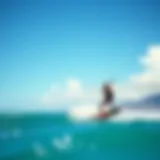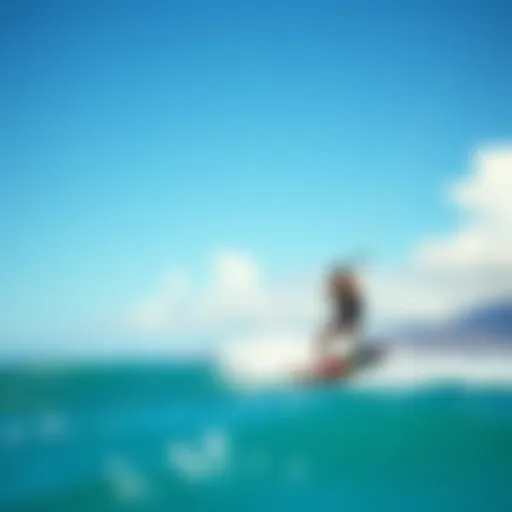Enhance Your Kiteboarding with the Korua Transition Finder
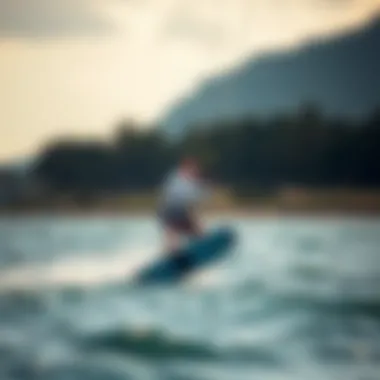
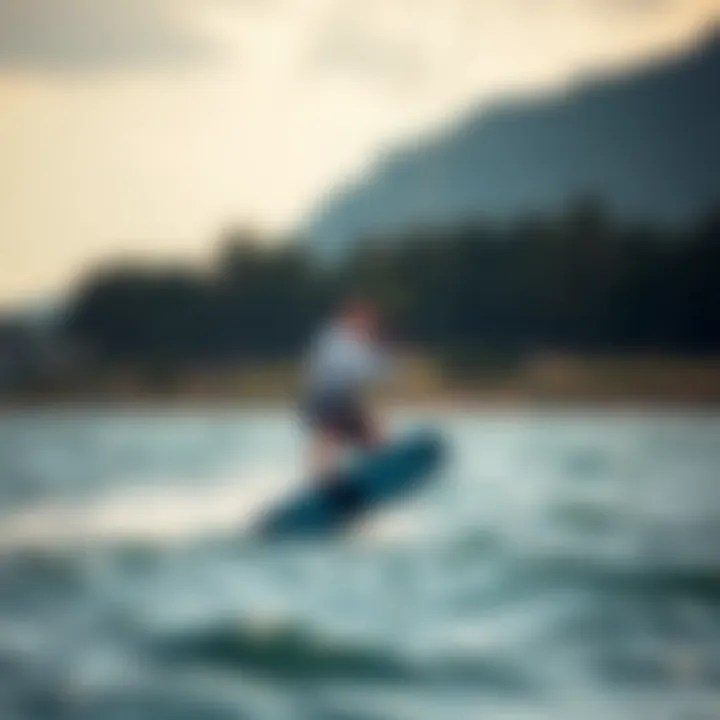
Intro
Kiteboarding, a dance between wind and water, demands not just skill but also the right tools to refine those techniques. Enter the Korua Transition Finder—a device that stands out in the crowded kiteboarding market. As kiteboarders strive for smooth transitions, this tool promises to illuminate the path toward mastery. It is designed to enhance overall performance by making the often tricky moments of switching directions or maneuvers feel more fluid and intuitive.
The Korua Transition Finder isn’t just another gadget; it is a resource for everyone from beginners to seasoned pros. Whether you ride to chill or aim for jaw-dropping tricks, understanding how to leverage this tool can be a game changer. Curious about how it works? Let’s dig deeper into its gear insights and explore how it can elevate your kiteboarding experience.
Understanding Korua Transition Finder
Kiteboarding, while exhilarating, often poses challenges that can hinder the flow of a session. Among the critical techniques is the transition, which allows kiteboarders to shift directions smoothly. The Korua Transition Finder emerges as a pivotal tool in mastering these essential movements. Understanding its workings is not just about grasping another technique; it can truly elevate one’s kiteboarding experience.
What is the Korua Transition Finder?
The Korua Transition Finder is an innovative tool engineered explicitly for kiteboarders. It provides a structured approach for executing transitions — those moments when a kiteboarder shifts direction without losing momentum. Instead of relying solely on intuition, this tool offers guidelines and visual cues that assist users in refining their technique. It's all about harnessing the wind efficiently, improving both agility and control while minimizing the risk of wipes.
Historical Context and Development
To appreciate the Korua Transition Finder fully, one must consider its roots. The evolution of kiteboarding has seen myriad leaps in technology and technique. Initially, riders relied on word-of-mouth tips or observations from seasoned athletes. However, the increasing popularity of kiteboarding necessitated a more systematic approach to transitions. As athletes shared experiences and training methods, the concept of a tool like the Korua Transition Finder came to fruition. This development reflects a broader trend in extreme sports where technology and education intertwine, aiming to promote skill enhancement and safety.
Core Principles of the Tool
At the heart of the Korua Transition Finder lies a few core principles:
- Simplicity: The tool emphasizes straightforward techniques that can be easily grasped, especially by beginners.
- Visual Guidance: It often incorporates visual elements, making it easier for users to conceptualize maneuvers.
- Feedback Mechanism: Users can assess their performance in real-time, encouraging continuous improvement.
These principles not only enhance the learning experience but also foster confidence among riders. By breaking down transitions into digestible components, kiteboarding becomes accessible to a broader audience, from seasoned pros to novices just starting their journey.
The Korua Transition Finder is not merely a tool; it embodies a movement towards greater understanding and skill in kiteboarding.
Analyzing Transition Techniques
Transitioning in kiteboarding isn’t just about fancy maneuvers; it’s a crucial component that enhances performance, efficiency, and overall enjoyment on the water. Analyzing these techniques provides kiteboarders with a deeper understanding of what makes a successful transition and how to achieve it effectively. It connects the dots between technique, skill development, and performance improvement, serving as a compelling reason for riders to delve into these practices thoroughly.
By examining different types of transitions, the critical factors that influence their success, and the common challenges that arise, riders can build a more solid foundation. This analysis not only helps beginners grasp the fundamental skills required but also allows seasoned kiteboarders to refine their techniques and tackle tougher maneuvers with confidence.
Types of Transitions in Kiteboarding
Transition techniques can vary widely based on an individual's style, environment, and kite type. Here are some of the key transitions that kiteboarders often employ:
- Heel to Toe Transition: This is one of the most basic yet essential transitions, allowing the rider to shift directions seamlessly while maintaining speed.
- Jump Transition: This involves using a jump to change direction, which adds flair to the ride and can impress onlookers. Here, timing and kite control are paramount.
- Surface Transition: Involves going from one posture to another on the water's surface, often used for smoother shifts without losing momentum.
- Downwind Transition: This technique takes advantage of the wind direction, requiring a sharp turn while maintaining control, often used in advanced tricks.
Each of these transitions plays a unique role in a rider's ability to navigate the currents and winds effectively, making them key in any kiteboarding toolkit.
Critical Factors for Successful Transitions
Successful transitions hinge on several critical elements that kiteboarders must consider:
- Timing: A well-timed technique can make or break a transition. Rushing or hesitating can lead to mishaps.
- Kite Positioning: Keeping the kite at the right angle and height is essential. This affects lift and control during the maneuver.
- Body Position: Proper body alignment and balance directly influence the transition's effectiveness. Riders should practice maintaining a low center of gravity.
- Wind Conditions: Understanding and adapting to the wind's behavior plays a significant role. Riders should check wind strength and direction before attempting maneuvers.
- Equipment Setup: Proper tuning of the kite and board ensures maximum performance. A misfit can hamper maneuverability.
By focusing on these factors, kiteboarders can enhance their ability to transition fluidly, elevating their overall performance.
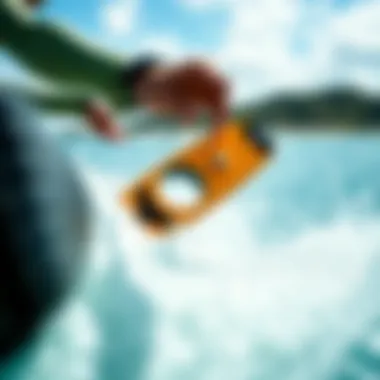
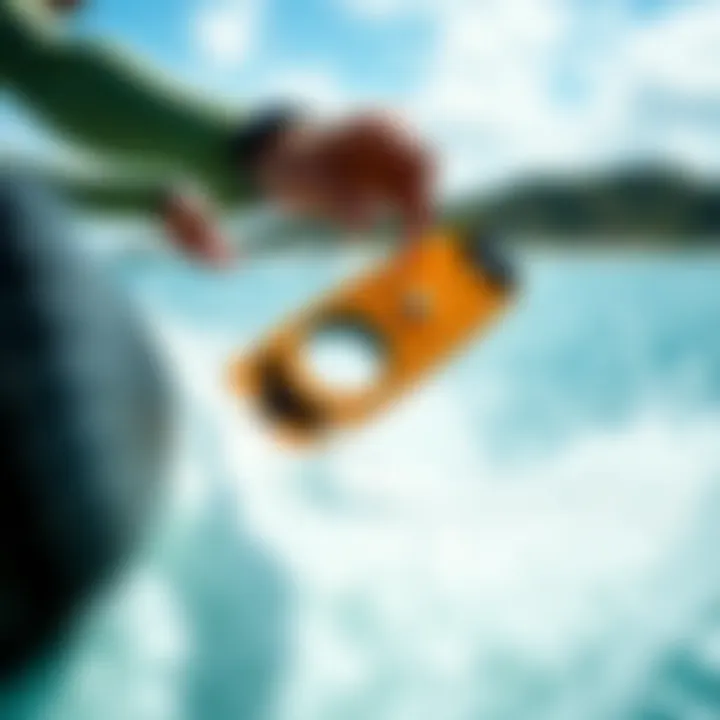
Common Challenges and Solutions
While transitioning, many kiteboarders encounter specific challenges. Recognizing these issues can help devise effective solutions:
- Loss of Speed: Riders may find themselves slowing down during transitions. A common fix is to practice maintaining tension in the lines and ensuring they're cutting into the wind adequately.
- Kite Stalling: A stalled kite can lead to a crash landing. This often happens when a rider fails to manage the kite properly through the transition. Practicing kite control during low-speed maneuvers can mitigate this.
- Poor Landing Alignment: Landing at an awkward angle can lead to wipeouts. Riders can work on their landing techniques by visualizing the landing spot before executing the transition.
- Misjudging Wind Changes: Weather can be unpredictable. Keeping an eye on the immediate environment and adjusting techniques in accordance helps in staying in control.
Effectively addressing these challenges can lead to improved safety and an overall better kiteboarding experience. The insights gained from analyzing transition techniques provide a roadmap for both the novice and the seasoned kiteboarder, proving that mastery of transitions is integral to success on the water.
Implementing the Transition Finder Effectively
Implementing the Korua Transition Finder into your kiteboarding toolkit can be a game-changer. It not only enhances your transition techniques but can also elevate your overall performance on the water. Mastering the use of this tool requires understanding its functionality, recognizing its benefits, and adapting it to fit individual styles. Here’s a more in-depth look at how to effectively incorporate the Transition Finder into your kiteboarding practice.
How to Use the Korua Transition Finder
Using the Korua Transition Finder can feel a bit tricky at first, but once you grasp its core functions, it becomes second nature. First, one must familiarize themselves with the tool’s layout and functionality. Here’s a simplified approach to get started:
- Assess Your Current Technique: Before anything, take a moment to evaluate your existing transition skills. What works for you, and where do you stumble?
- Set the Transition Finder According to Your Needs: The tool allows you to adjust settings based on wind conditions and your skill level. Make sure to tweak these parameters thoughtfully.
- Follow the Streamlined Instructions: The Transition Finder often provides in-depth guidance as you practice. Ensure to follow these instructions during your training sessions rigorously.
- Practice in Various Conditions: Don’t limit your usage to ideal circumstances. Practicing under varied conditions will give you a broader understanding of transitions and prepare you better.
As with anything, practice makes perfect. Regular use in different settings will naturally build your confidence and skill level over time.
Best Practices and Techniques
To truly harness the power of the Korua Transition Finder, employing best practices is essential. Here are some techniques that can smooth out your transitions:
- Slow and Steady Wins the Race: While it might be tempting to jump straight to advanced tricks, focusing on perfecting basic transitions will create a solid foundation for more complex maneuvers.
- Stay Relaxed: Tension in your body can lead to erratic movements. Focus on maintaining a relaxed state, as this allows for smoother transitions and better control over your kite.
- Consistent Foot Placement: Pay attention to where you place your feet in the straps. Consistency will lead to a more balanced approach during transitions.
- Utilize Visualizations: Sometimes it helps to visualize each move before executing it physically. Picture each step required to make your transition as seamless as possible.
These practices not only help with smooth transitions but also build a level of confidence in one’s abilities on the water.
Tailoring Usage to Individual Style
Every kiteboarder has a unique style, and understanding how to tailor the use of the Korua Transition Finder can make all the difference. Evaluate how you ride and determine what aspects can be improved using the Transition Finder. Here are some considerations:
- Identify Your Riding Style: Are you more aggressive, or do you prefer a smoother, more fluid approach? Tailoring your practice sessions based on this can enhance your effectiveness with the tool.
- Adjust Settings Accordingly: The Transition Finder allows users to customize settings. Adjust according to your style and preferred transition techniques.
- Seek Guidance from Peers: Don’t shy away from asking fellow kiteboarders how they integrate the Transition Finder into their style. Sharing insights can spark new ideas for incorporation.
"It’s not just about mastering a tool; it’s about understanding how it complements your ride. Find your rhythm and let the Transition Finder guide you." - An avid kiteboarding enthusiast.
In summary, implementing the Korua Transition Finder effectively is about marrying your unique riding style with the functionalities of the tool. Mastering this balance will undoubtedly give any kiteboarder the edge they seek.
User Experiences and Testimonies
In the pursuit of mastering kiteboarding techniques, user experiences hold significant value. They provide real-world insights and lend credibility to new tools like the Korua Transition Finder. Feedback from fellow kiteboarders serves not just as a reflection of individual journeys, but also as a means to foster a community of shared knowledge. By examining the experiences of both novice and seasoned kiteboarders, we can uncover the real impact of the Transition Finder in enhancing performance on the water.
Feedback from Novice Kiteboarders
For many novice kiteboarders, embarking on the adventure of kiteboarding can be a daunting task, filled with uncertainty amid rapid winds and rising waves. The Korua Transition Finder has emerged as a beacon of guidance, simplifying what often feels like a complex dance of maneuvering. One beginner shared their thoughts, stating, "The Transition Finder has helped me to focus on my foot positioning while turning. I was once overwhelmed, but now I feel more confident as I ride across the waves."
This sentiment echoes among many other learners who have found the Transition Finder to be vital in their development.
- Clear Guidance: Novices often appreciate the step-by-step breakdown that the Transition Finder provides. It illuminates the pathway from a simple turn to a more fluid transition between maneuvers.
- Instant Feedback: With the Transition Finder, users have reported being able to receive feedback on their performance sooner than they would have in traditional learning environments.
- Confidence Boost: As new kiteboarders successfully execute transitions using the tool, their confidence flourishes, leading to a more enjoyable learning experience.
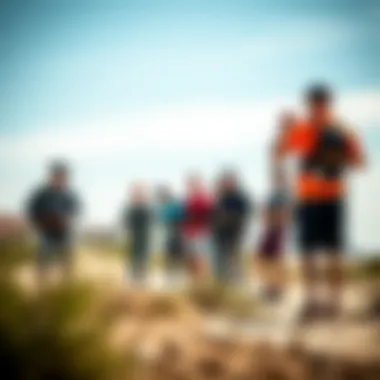
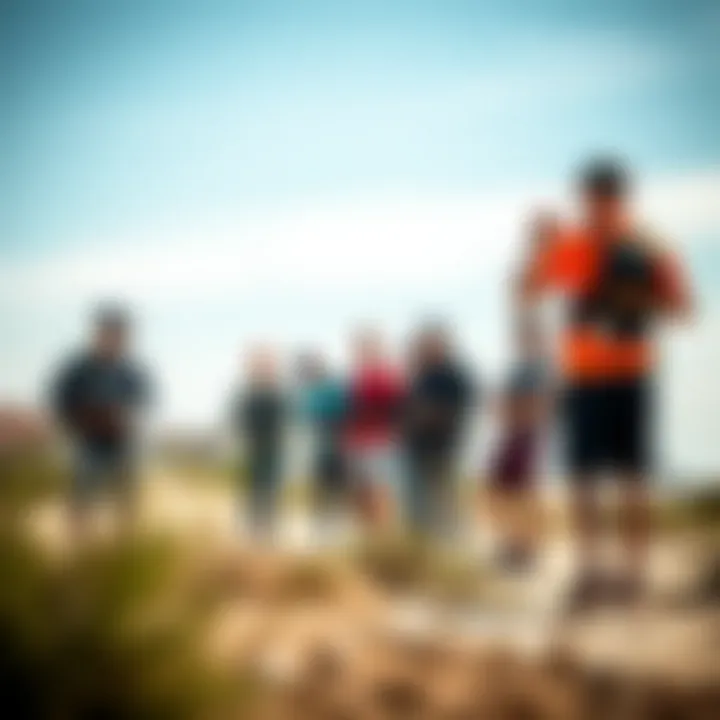
Insights from Experienced Athletes
At the other end of the spectrum lies the seasoned kiteboarder, whose pursuit for precision and style is never-ending. Experienced athletes approach the Korua Transition Finder with a different perspective. Their feedback, rich with technical analysis, reveals how the tool can fine-tune their techniques. One athlete remarked, "Using the Transition Finder has not only improved my transitions but has also made me explore different styles I didn't think were possible. It’s like having an additional coach on the water."
For these riders, the insights they offer include:
- Refining Techniques: The Transition Finder allows them to focus on subtle shifts in weight distribution and timing that can make a significant impact on their performance.
- Adapting to Conditions: Experienced riders value the tool for its adaptability to various wind and water conditions, which is crucial for competitive scenarios.
- Personalized Progress Tracking: Many athletes appreciate the capability to track their progress over time, analyzing what works best for them and allowing them to further tailor their styles.
Comparative Analysis with Other Tools
When discussing user experiences with the Korua Transition Finder, it's vital to draw comparisons with other existing tools in the kiteboarding world. Some kiteboarders have tested various transition aids and have found the Transition Finder to stand out remarkably.
- User-Friendly Interface: Compared to other tools that can be clunky or overly complicated, users often cite the Transition Finder’s intuitive design as a major plus.
- Detailed Visuals: While some products merely provide textual instructions, the visual representations in the Transition Finder make complex movements easier to grasp.
- Community Feedback: Unlike some alternatives that lack a communal aspect, the Korua Transition Finder thrives on community engagement. It encourages users to share their results and techniques, enhancing the learning process further.
Overall, the experiences shared by novice and seasoned kiteboarders underline a common truth: the Korua Transition Finder is not just a tool; it’s a bridge that connects various levels of kiteboarding expertise, fostering growth and enhancement across the board.
The Role of Conditioning and Physical Readiness
Conditioning and physical readiness play a pivotal role in kiteboarding, especially when it comes to successfully executing transitions. The sport demands not only a strong understanding of technique but also significant physical prowess. Having a solid base of fitness allows kiteboarders to respond to the dynamic nature of the water and wind, making their movements smoother and more efficient. This section delves deeper into the essentials of physical conditioning and mental preparation that are crucial for mastering kiteboarding techniques.
Physical Requirements for Kiteboarding
To get the most out of kiteboarding, being in good physical shape is non-negotiable. The physical requirements include strength, endurance, flexibility, and balance.
- Strength: Upper body strength is vital since kiteboarders need to steer and manage the kite amidst robust winds. Core strength helps maintain stability on the board, while leg strength is crucial for powerful maneuvers.
- Endurance: Kiteboarding sessions can last for hours, demanding stamina to endure extended periods on the water. A kiteboarder must be able to withstand fatigue and keep their energy levels high.
- Flexibility: Good flexibility allows for a broader range of motion, which is essential for performing complex tricks and maneuvers.
- Balance: The ability to maintain balance is fundamental, as kiteboarding requires constant adjustments to shifting weights and changing conditions.
Developing a balanced fitness regimen that includes strength training, cardio, and flexibility exercises can greatly assist in meeting these physical demands. Incorporating activities like yoga or pilates can help improve flexibility while building core strength.
Mental Preparedness and Focus
Just as critical as physical readiness is mental conditioning. Kiteboarding involves not just physical skill but also substantial mental acuity. The following aspects are fundamental to enhancing mental preparedness:
- Visualization: Successful kiteboarders often utilize visualization techniques to mentally rehearse maneuvers before executing them. This practice allows them to prepare for various scenarios, making them more adaptable on the water.
- Concentration: Maintaining focus in the face of distractions—like changing weather conditions or other kiteboarders—is essential for performance. It’s important for kiteboarders to hone their ability to stay in the zone, filtering out unnecessary distractions.
- Stress Management: The ocean can be unpredictable. Developing strategies for managing stress, whether through mindfulness or breathing exercises, can help keep nerves in check and maintain a clear head during rides.
Incorporating mental exercises alongside physical training can lead to a well-rounded approach, preparing one for both the known and the unforeseen challenges kiteboarding presents.
Integrating Fitness into Routine
Creating a fitness routine tailored to kiteboarding involves combining both physical and mental aspects in a structured way. Here’s how to seamlessly integrate fitness into your daily life:
- Scheduled Workouts: Carve out time for targeted workouts focusing on strength, endurance, and flexibility within your weekly schedule. Consistency is the key.
- Cross-Training: Engage in other sports or activities that enhance your overall fitness, such as swimming, windsurfing, or even rock climbing. These activities help build complementary skills while keeping training enjoyable.
- Mindfulness and Meditation: Setting aside time for mental training can be beneficial. Daily practices, even for a few minutes, can enhance focus and reduce stress levels.
- Nutrition and Hydration: Fueling your body with the right nutrients and staying adequately hydrated is just as important as physical training. A well-balanced diet can significantly affect performance on the water.
"Preparation breeds confidence; when your body and mind are aligned, you'll sail smoother through life’s waters."
Safety Considerations
Safety is a cornerstone of kiteboarding, particularly when utilizing tools like the Korua Transition Finder. It’s crucial for enthusiasts to not only enhance their skills but to do so in a manner that prioritizes health and well-being. The nature of this sport, with its combination of wind, water, and equipment, makes awareness and preparation vital. Overlooking safety can lead to accidents, injuries, or worse. Integrating safety considerations not only fosters good practices but also adds to the overall enjoyment and longevity in the sport. By emphasizing these elements, kiteboarders can confidently navigate the waters while learning and perfecting their techniques.
Recognizing and Mitigating Risks
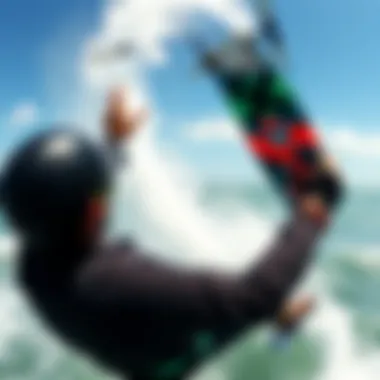
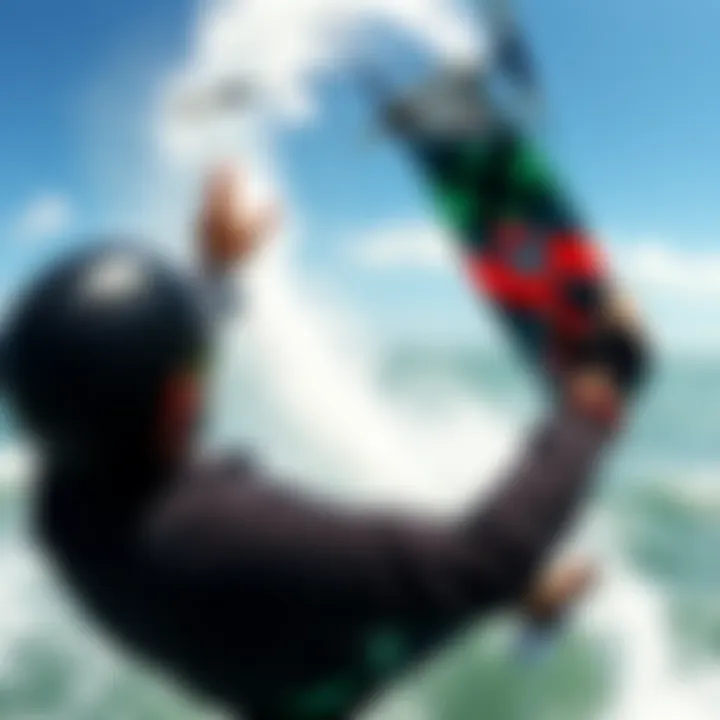
Understanding the environment you kiteboard in is the first step towards risk mitigation. Factors such as wind conditions, wave size, and the presence of other water users can pose significant dangers.
- Assessing Wind Conditions: Before heading out, check wind patterns and forecasts. High winds can quickly turn a fun session into a perilous situation, especially for less experienced riders.
- Awareness of Other Water Users: Beaches might be crowded with swimmers, surfers, or boats. Knowing your surroundings prevents accidents, akin to navigating a busy street.
- Spotting Hazards: Look for rocks, buoys, or shallow areas that could cause accidents. A sudden dip in water depth can catch you off guard.
"The ocean is as unpredictable as it is beautiful. Always keep your eyes open and your wits about you."
Mitigating these risks includes preparation and instinct. Having a plan B, such as knowing where to exit the water, is essential. This includes familiarizing yourself with local rules and conditions, which can change with the seasons.
Essential Safety Gear for Transitions
While skill and technique are crucial when kiteboarding, the right gear adds an extra layer of safety. Essential safety equipment can make the difference between a close call and a serious incident.
- Helmet: Protects your head from falling objects or impacts with the water.
- Impact Vest: Offers support and buoyancy in case of a fall.
- Safety Leash: Helps keep your kite connected, reducing the risk of losing control.
- Life Jacket: Especially vital for beginners or those kitesurfing in gusty conditions.
Using the right gear ensures that when making transitions, kiteboarders can do so with confidence, knowing they have the right protection. Additionally, staying updated on gear advancements can enhance safety measures over time.
Adherence to Local Guidelines and Practices
Every kiteboarding location may have different rules and protocols to ensure safety for all participants. Familiarizing yourself with these regulations not only keeps you safe but fosters a respectful community around the sport. Practical adherence includes:
- Local Ordinances: Some areas may have restrictions, such as designated zones for kiteboarding to prevent crowded waters.
- Check-In Procedures: Certain locations may require check-in with lifeguards or other authority figures to monitor conditions.
- Surface Conditions and Hazards: Keeping updated on local conditions is vital, as changes can occur rapidly.
Kiteboarding is more pleasurable when all participants play their part in maintaining a safe environment. By following guidelines and participating in safety briefings, you contribute to a culture of respect and awareness that benefits everyone on the water.
In closing, kiteboarding is undeniably exhilarating, but it thrives on the principles of safety and responsibility. By recognizing risks, utilizing gear properly, and adhering to local practices, kiteboarders can better navigate their journey on the water.
Future of Transition Techniques in Kiteboarding
The kiteboarding realm stands on the edge of exciting advancements, particularly with the facilitation of tools like the Korua Transition Finder. Transition techniques have become a key focus area, influencing not only performance but also safety and enjoyment of the sport. As kiteboarding evolves, understanding these future techniques is crucial for enthusiasts, instructors, and innovators in the field.
Emerging Trends and Innovations
Innovation isn’t just a buzzword in kiteboarding; it’s the very heartbeat that keeps the sport alive. The future holds countless trends focusing on smoother transitions, which can lead to significantly better performance on water. Techniques such as power glide and controlled flips are gaining traction, with kiteboarders blending style and efficiency.
Moreover, kite manufacturers are exploring lightweight materials, which amplify maneuverability. The advent of hybrid kites may change how riders approach their transitions, allowing for enhanced control during high-speed maneuvers. Here are some trends to keep an eye on:
- Smart Kites: That can adjust themselves to wind conditions in real time.
- Wearable Technology: Like smart watches measuring performance metrics
- AI Coaching: Online platforms providing real-time feedback based on recorded sessions
Finding avenues to harness these innovations could change the dynamics of kiteboarding entirely.
The Impact of Technology on Skill Development
Technology, in many cases, is the great equalizer. For kiteboarding, its impact can’t be overstated when it comes to skill enhancement. The integration of software tools with real-time feedback allows riders to analyze their techniques meticulously. Using performance tracking apps, riders can receive insights on various elements:
- Speed during Transitions: Helps in understanding what’s working and what isn’t.
- Video Analysis: Captures the rider's movement, providing a practical resource for learning.
- Community Share: Riders can exchange tips and techniques through platforms like Reddit and specialized forums.
As instructors adopt these technologies, they can tailor lessons suited to individual learning styles, taking the guesswork out of improvement. With this level of analysis, students can leapfrog over traditional learning curves, mastering transitions to a fault faster than ever.
Encouraging Community and Contribution
In the world of kiteboarding, community plays a pivotal role—one that fosters growth and progress. The future hinges upon collective efforts, and platforms encouraging contributions from various riders are absolutely vital.
Imagine a scenario where seasoned riders share their secret transition techniques through an open-source platform. This could create an invaluable repository of information accessible to all skill levels. Engaging with community members on platforms like Facebook can boost motivation and create spaces for collaboration.
Furthermore, workshops and local meet-ups help cultivate nurturing environments for learning and sharing knowledge. The synergy among kiteboarders from different backgrounds can lead to the win-win of innovation, pushing each everyone towards higher levels of skill and creativity.
"Together we'll rise, and together we will maneuver through the best transitions yet unseen."


